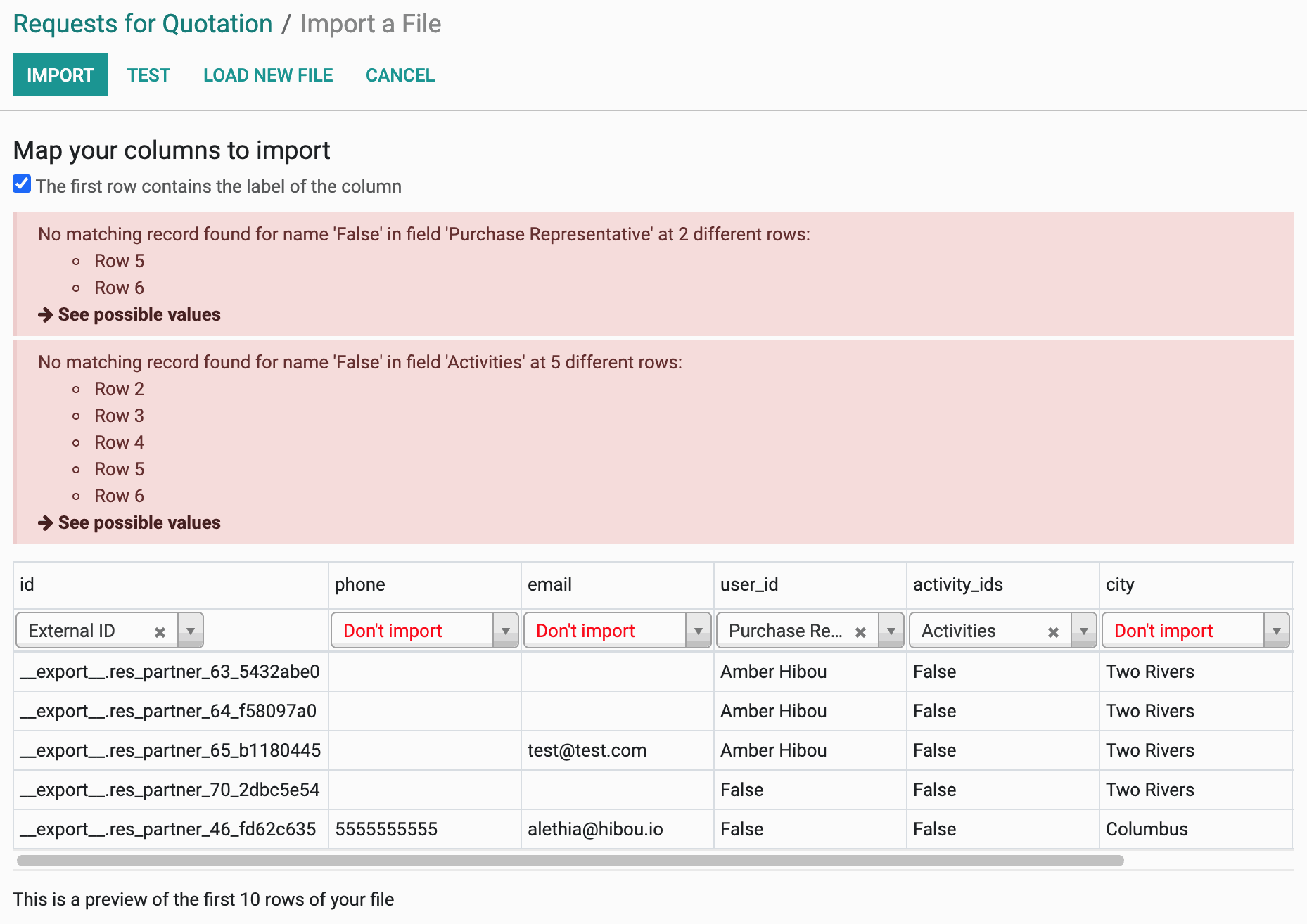Purchase: Orders
Purpose
This document will cover Requests for Quotation (RFQs), Purchase Orders, how to view Incoming Product, and create vendor bills.
Please note that in order to follow this workflow, you must have at least one contact designated as a vendor, and one product that is configured to be purchased from that vendor.
To create a new vendor, see Managing Contacts.
To create a new product and configure its variants, see the Product Creation Workflow.
Process
To get started, navigate to the Purchase app.
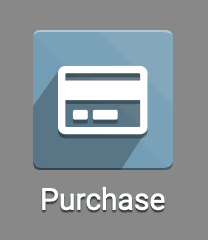
Requests for Quotation (RFQ)
The default view of the Purchasing app is a list of current RFQs. These are the draft form of purchase orders that have not yet been confirmed and sent to vendors. While in draft stage, it is possible to change the vendor you would like to purchase from, add and delete products, adjust quantities, and change the destination warehouse.
Some RFQs are generated automatically by the scheduler based on your reordering rules per product. Odoo will compare the product’s Quantity on Hand against the Minimum Quantity on reordering rules to create an RFQ based on the difference (if the product uses the Buy route). Automatically generated RFQs from reordering rules will reflect the quantity you need to purchase to fulfill outbound transfers for this product that are waiting availability and bring you back up to your Maximum Quantity.
Click Create to start a manual RFQ. Select your Vendor, and then add the products you wish to purchase.
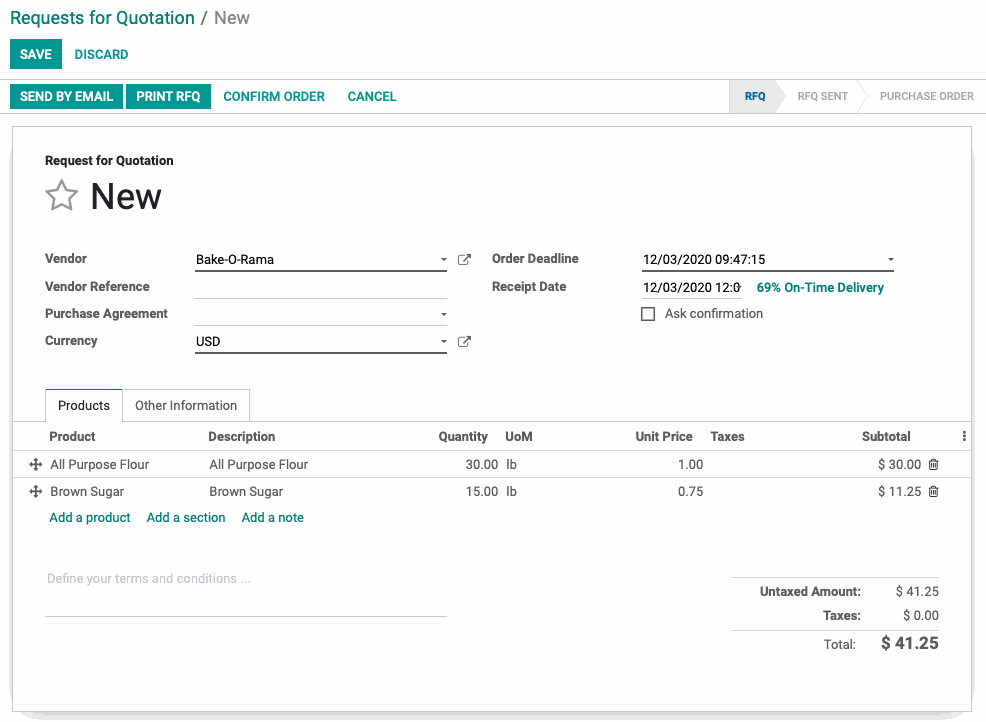
Once the products are added, you can adjust the quantities and price as needed. Once your information is complete, click Save.
You have the option to send your RFQ to the vendor to confirm the quantities and ensure they will be able to fulfill the order by using the Send By Email function.

This brings up a modal window with a preview of the email to be sent along with the RFQ as a PDF attachment. When you're ready, click Send.
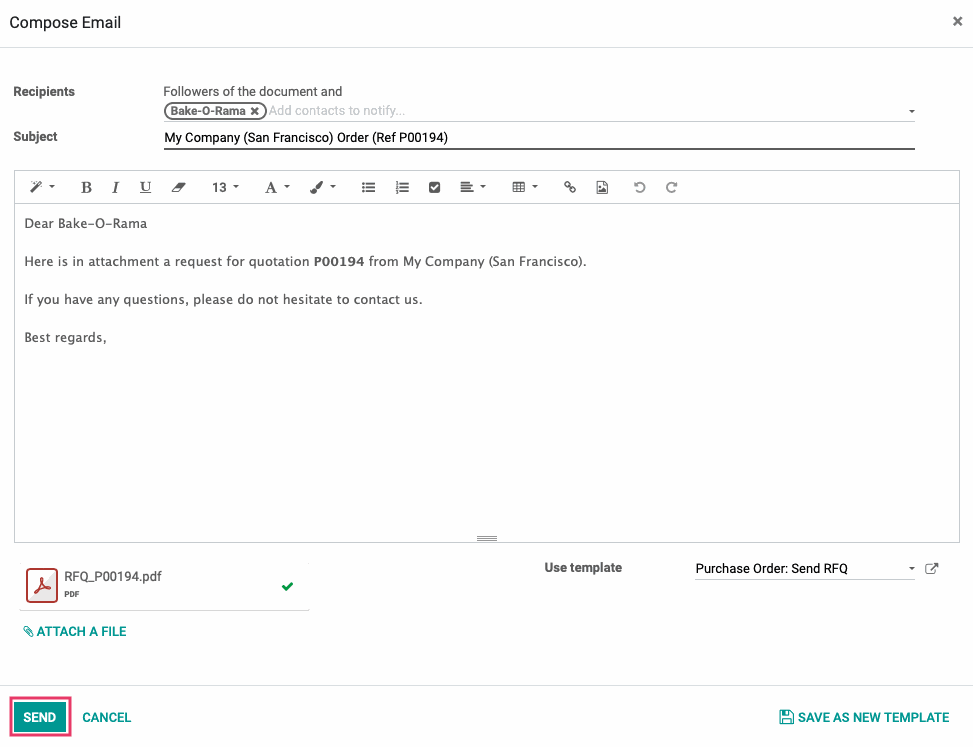
When you've gotten confirmation from the vendor, click Confirm Order.

Confirming the RFQ turns it into a Purchase Order. If you've enabled "Lock Confirmed Orders" in settings, the Purchase Order will be in Locked stage. You will also see a Receipts smart button appear in the top right corner.

Purchase Orders (POs)
Click Orders > Purchase Orders.
This page offers a quick overview of each PO's status.

Sorting Purchase Orders according to Billing Status can be a quick way to easily categorize them. To view Purchase Orders, click Orders > Purchase Orders. You have the option of using a Custom Filter to only view a specific Billing Status: "Nothing to Bill", "Waiting Bills" or "Fully Billed".

You can also Group By Billing Status by selecting Add Custom Group and then Billing Status.

Good to Know!
Control Policy + Create Bill
If the invoice policy is set to invoice on delivered quantities, then you will not be able to create a vendor bill until the product is received. In this case, the Create Bill button will be white. Clicking the button will give the following error:

Skip to the Receiving Products section before creating a bill.
Otherwise, the option to CREATE BILL based on ordered quantities will appear in the top left corner.
Purchase Agreements
There are two types of purchase agreements in Odoo, called a Blanket Order and Call for Tender. These types are configurable in the Purchase app configuration settings.
Blanket Order: This type of agreement is like a standing purchase order and is used to manage recurring purchases of certain products from a vendor over a set period of time or in certain quantities.
Call for Tender: This agreement type will allow you to request price updates on a product from multiple vendors to make sure you are getting the best rate. If Select only one RFQ is chosen in the configuration options, then selecting the winning bid will cancel the other RFQs.


To create a purchase order with a certain purchase agreement in place, navigate to ordErs >PURCHASE AGREEMENTS and click crEate.
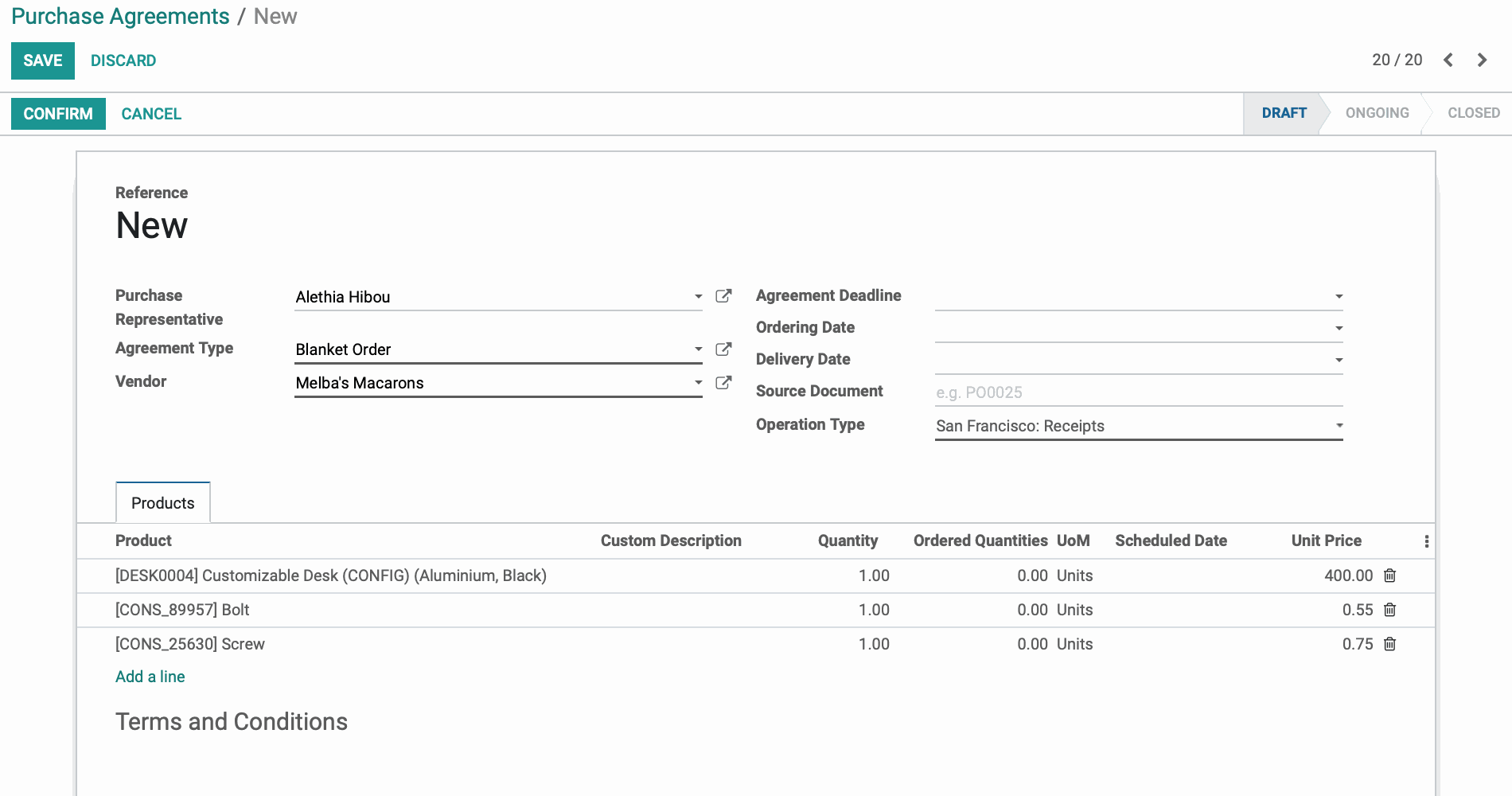
You will see the following fields:
Purchase Representative: Select the contact responsible for this purchase agreement. By default, this will be your name.
Agreement Type: Select the Purchase Agreement Type that applies.
Vendor: Select the vendor you wish to purchase from
Agreement Deadline: Enter the date in which this offer is no longer valid.
Ordering Date: Enter the anticipated order date.
Delivery Date: Enter the anticipated delivery date
Source Document: If applicable, enter an order reference number (e.g. Purchase Order number).
Operation Type: There are three basic operations carried out in a warehouse: Receipts,Internal Transfer, and Delivery Order. However, you can add more custom operations from the Inventory app under Configuration > Warehouse Management > Operation Types > Create.
In the Products Tab, you will see the following:
Product: Enter the product(s) you wish to purchase. If the product has variants, you'll be prompted to select the quantity of each.
Custom Description: You can enter a customized description of the product in this field.
Quantity: Select the quantity of the product you wish to purchase.
Ordered Quantities: This indicates the number of products already purchased based on this agreement and uses he historical data in Odoo. For this reason, you will not be able to edit this field.
UoM: This field auto-populate but may be edited.
Scheduled Date: The date the order is scheduled to leave the warehouse.
Unit Price: Enter the price per unit.
After selecting the agreement type, vendor, products and prices you'd like to include, click Confirm.
Once the agreement is saved, you will have the option to create new quotations under it. There will be a RFQs/Orders smart button in the top right corner of the record, indicating how many RFQs and POs are associated with the purchase agreement.
To create a draft quotation under this agreement, click New Quotation.
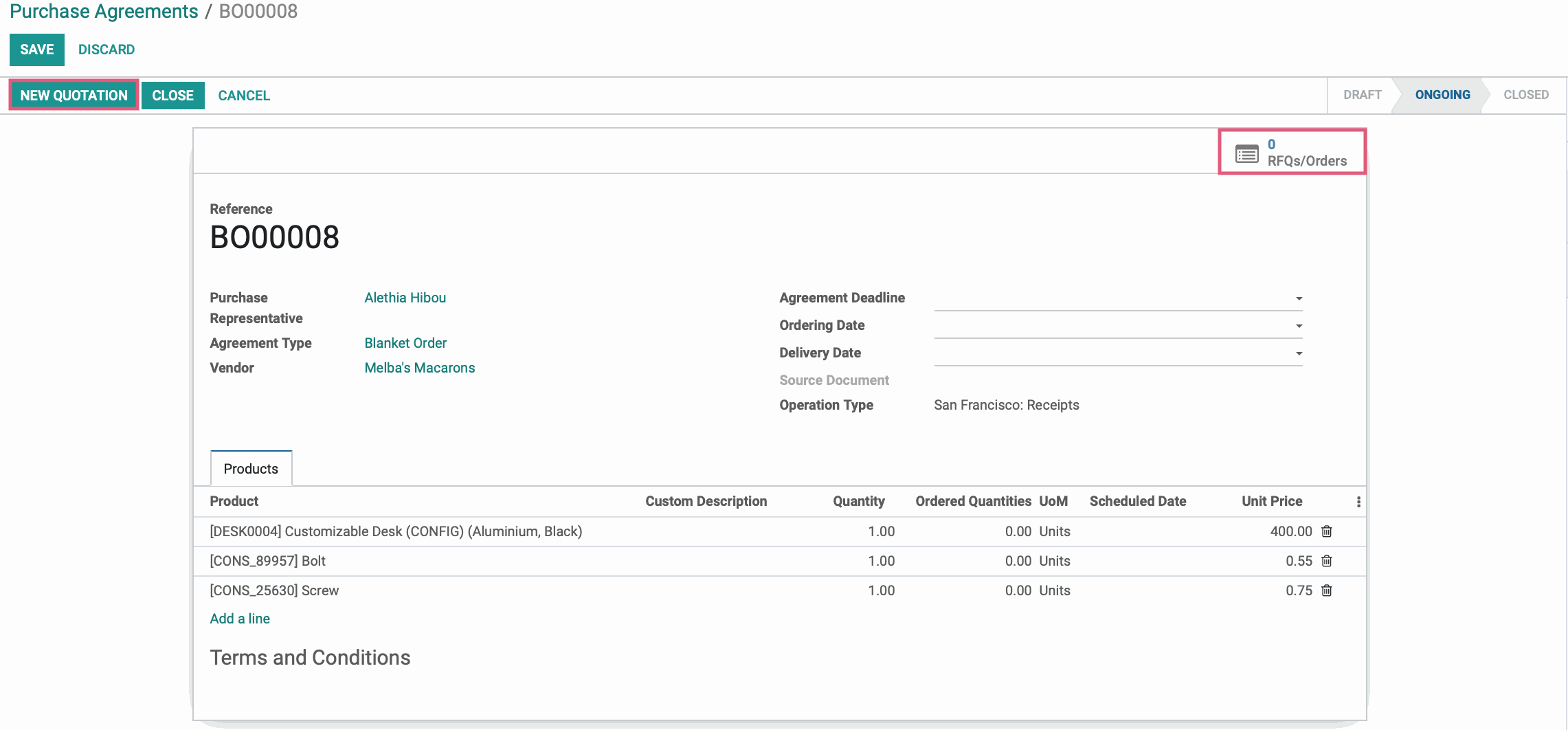
Fill out the quantities you’d like to purchase and set the expected delivery date on your new quotation and click Save, then Confirm Order.
The new purchase order will appear under the agreement's RFQs/Orders list for ease of reference, which can be found by clicking on the RFQs/Orders smart button.

Receiving Products
Whenever a Purchase Order is confirmed, Odoo will generate an operation type called a Receipt in the warehouse to which the products are expected to be delivered. From the purchase order, you will see a Receipt smart button appear in the top right corner of the window. You can either click RECEIVE PRODUCTS or the Receipt smart button to see the transfers and the destination warehouse.
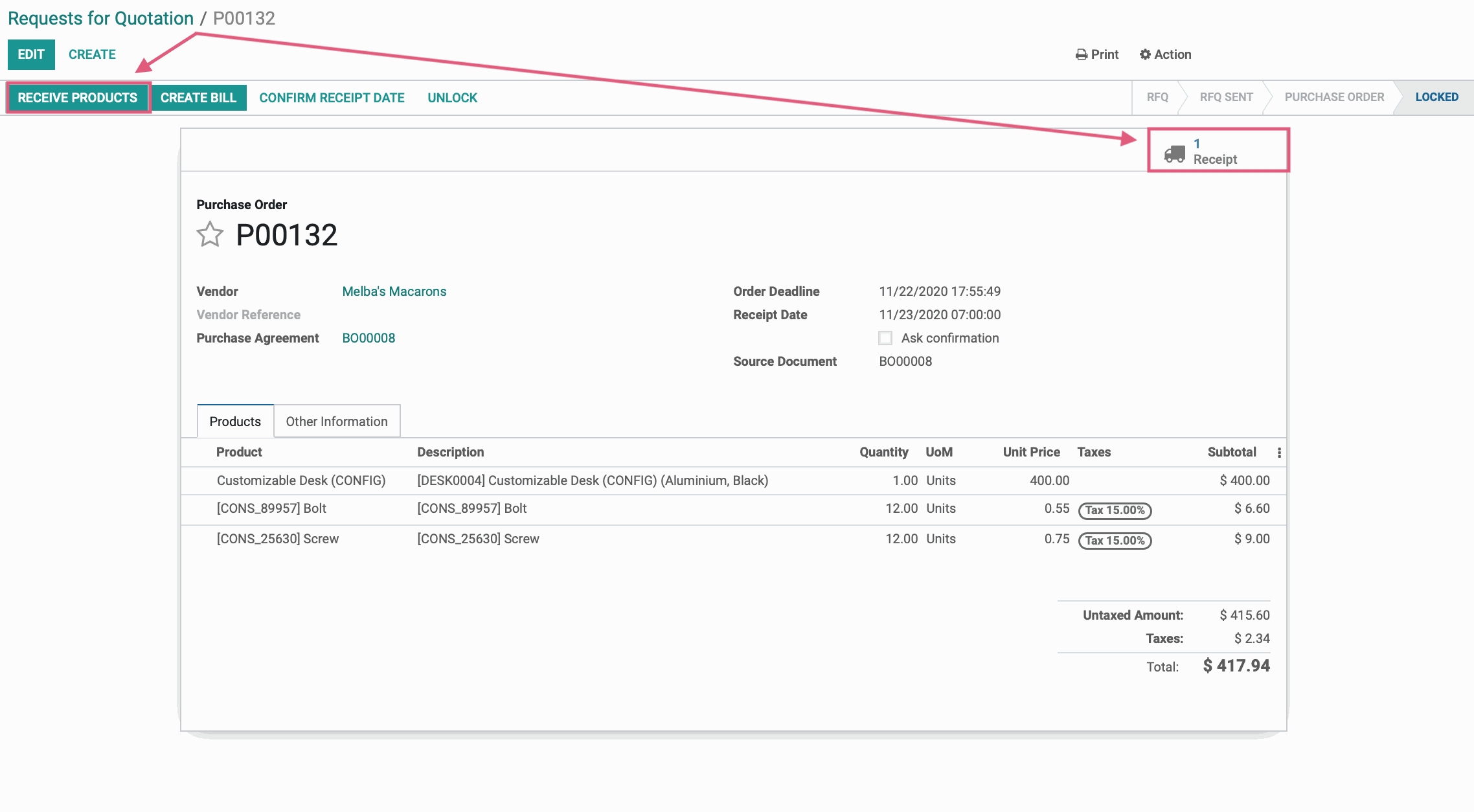
When the product arrives, click the Detailed Operations icon in the Operations tab and set Done Quantities (qty received) on the products.
If your Odoo instance is not configured to use packages or serial numbers, you may not see the Detailed Operations icon and instead will simply enter the done quantity on each line.


Click CONFIRM to set the quantity actually received. VALIDATE the inbound transfer, and this will add the product to your Quantity on Hand, removing it from the forecasted quantity.
Any product that is left undone due to damage or that is missing from the shipment can be turned into an operation type called a Backorder at this point. If you will not be receiving the remaining items from the vendor in the future, select No Backorder. The Backorder option will be available anytime a transfer cannot be completed as originally configured. It will reference its source for easy follow up and scheduling.


Vendor Pricelists
In the navigation bar, click configuration > Vendor Pricelists. You will be shown your vendors, the products purchased and at what price. It may be helpful to group by vendor to achieve a simple list to export or print.
The Import/Export function is useful for quickly updating information in your database. Select all of the products under a vendor and check the box that selects every record. Then, under the Action menu, click export.

In the following window, select Update Data (Import-compatible export) and choose your export file type. Odoo will have a list of recommended fields to use in your spreadsheet. Clicking > to the left of a field under Available fields will allow you to see the sub-fields. Clicking the + of a desired field will allow you to add it to the right under Fields to export. Click Export.
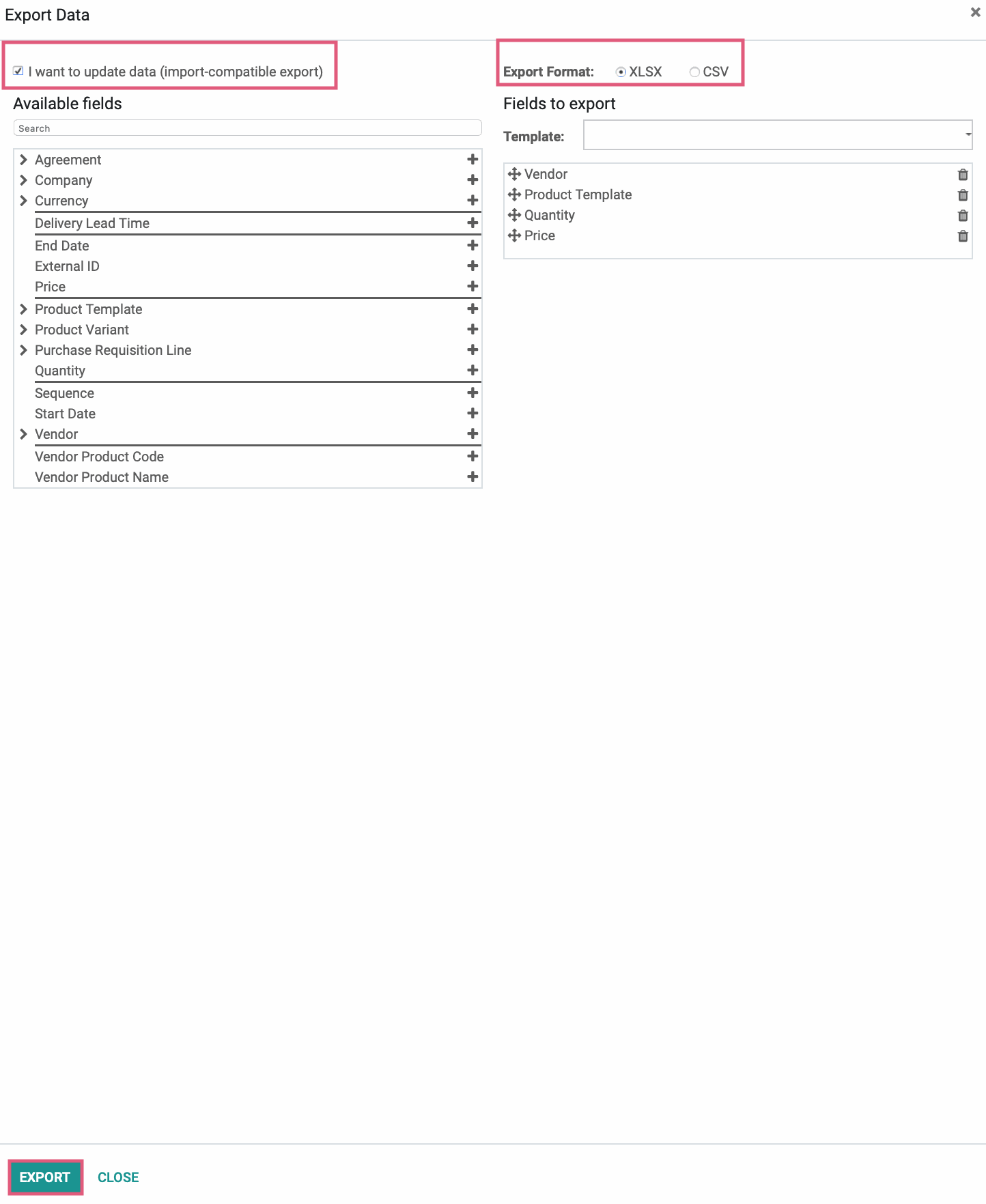
To import Pricelists, click Configuration > Vendor Pricelists. Select Import Records from the Favorites menu.

Next, click load file to select your chosen CSV or Excel file and then click import to upload your revised file. Odoo will try to match the headings based on the field names. If you exported from Odoo, this should be automatic, but if Odoo is mistaken on what certain columns contain, you can select them now.
Click Test in the top left to check for errors. A message stating the file is valid will appear if there are no errors.

Click Test to make sure there are no errors. A warning will appear in red above the column if there is an error. Correct any errors you encounter. If the field cannot be reconciled within Odoo, you have the option not to import it and update those fields manually.
